Lava Xolo X900 Review - The First Intel Medfield Phone
by Brian Klug on April 25, 2012 6:00 AM ESTBattery Life
Nailing performance is one thing, but in order to really sell Medfield and other upcoming SoCs to OEMs, Intel has to deliver battery life and power consumption that's competitive. It's about performance/power in the SoC space. First, it's worthwhile to note that the X900 includes a relatively small battery, at just 5.4 Whr. Of late, batteries over 6 Whr seems like the norm, and I'm told that future designs including the Motorola phone will probably include larger ones. It's just good to have that frame of reference and this chart should help:
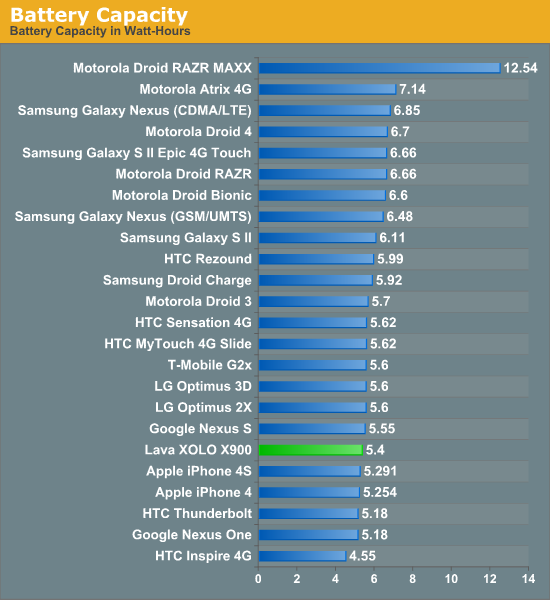
Intel notes battery life in their own X900 announcement blast as being around 5 hours of continuous 3G browsing and 8 hours of talk time. Our own numbers end up being pretty darn close, at 4.6 hours and 8.5 hours for those two metrics, respectively.
As a reminder, the browsing tests happen at 200 nits and consist of a few dozen pages loaded endlessly over WCDMA or WiFi (depending on the test) until the phone powers off. The WiFi hotspot tethering test consists of a single attached client streaming 128 kbps MP3 audio and loading four tabs of the page loading test through the handset over WCDMA with the display off.
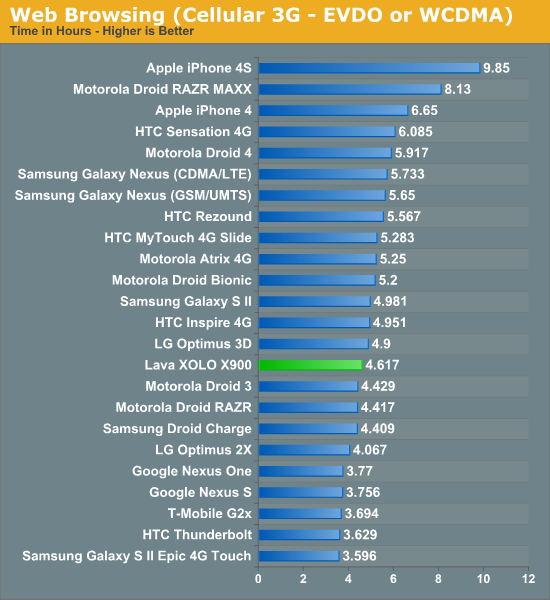
As a smartphone the X900 does a bit below average here, but as we mentioned it also has an unusually small battery for a modern flagship Android smartphone. If we divide battery life by battery capacity, we can get a better idea for how the Medfield platform compares to the competition:
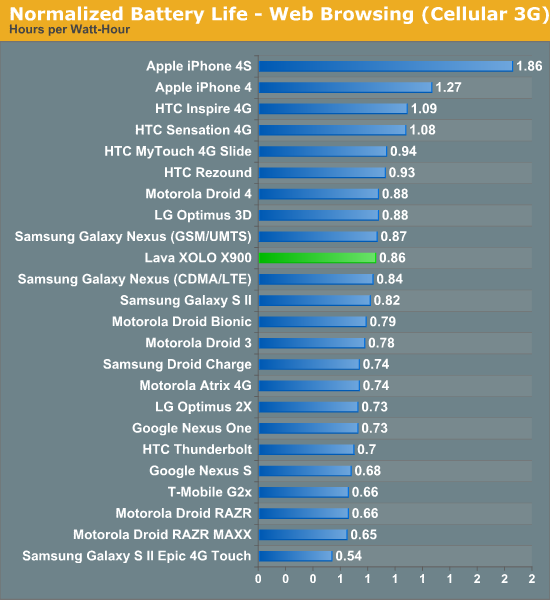
Normalizing for battery capacity, the X900 actually does a bit above average. In other words, the Medfield platform appears to be just as power efficient as some of the newer OMAP 4 based smartphones.
On WiFi the situation is no different:
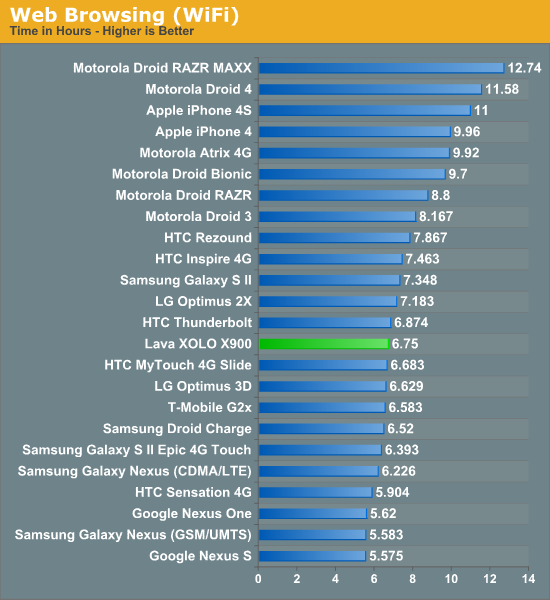
Again we see reasonable numbers for the X900 but nothing stellar. The good news is that the whole x86 can't be power efficient argument appears to be completely debunked with the release of a single device. To move up in the charts however, Intel needs to outfit its reference design with a bigger battery - something I've heard is coming with the Z2580's FFRD. The normalized results put the X900 at the middle of the pack:
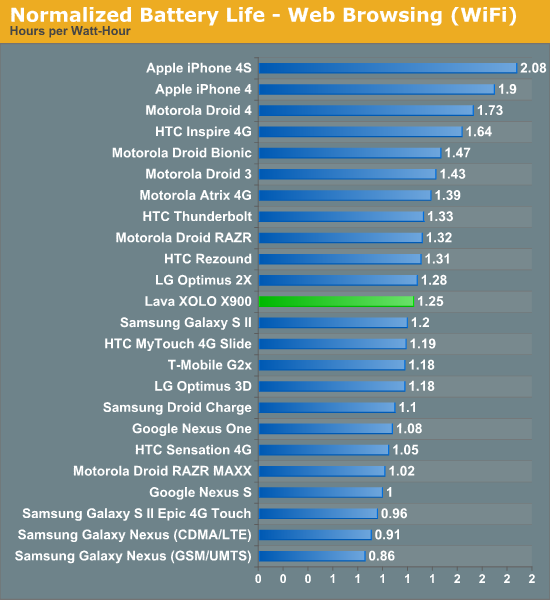
We see similar results in our talk time and 3G hotspot tests:

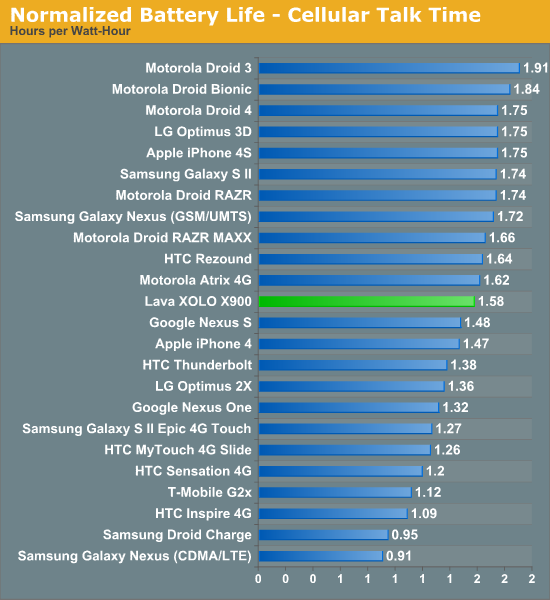
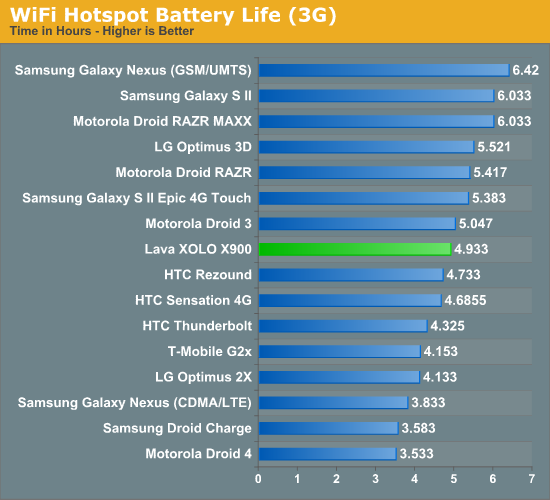
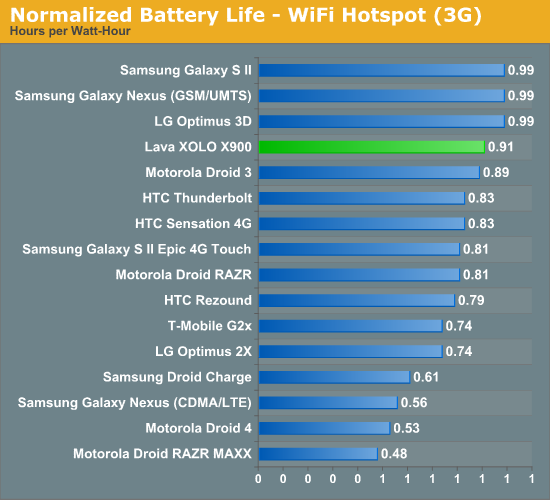










106 Comments
View All Comments
Splynn - Sunday, April 29, 2012 - link
I'm curious as to if there will be cost saving in the software development side of a tablet or phone. Intel is very good at developing platforms at this point that have a consistency from a software point of view (for example, PCIe works like a super set of PCI from a software point of view which was a big factor in its adoption).If this saves enough on the cost of development and maintaining the software, then it would seem to be a good option. But it would be a new way of doing business for the embedded market.
djgandy - Wednesday, April 25, 2012 - link
Not a bad attempt, sure there are better SoC's out there but considering the age of the current Atom architecture and how it began it's not faring too badly. Medfield is a pretty old chip in terms of design. I'd expect Intel to start tick-tocking with Atom soonname99 - Thursday, April 26, 2012 - link
The whole POINT is that Intel probably can't spin this as fast as ARM can. That has always been the more intelligent argument against Intel in this space-not that x86 is too large or too power hungry, but that it is so so so much more painful to design and validate, but any attempt to cut corners has the potential for embarrassing bugs like the pentium FPU bug.therealnickdanger - Wednesday, April 25, 2012 - link
I wonder how much better this phone would do with ICS loaded instead of GB? Will AT give this phone an update when the official ROM is released?Please forgive my ignorance - you could load Windows XP or Windows 7 on this thing, correct? Dual boot? Is there hardware that would restrict one from doing so? Seems to me that if it's just a glorified X86 Atom, it could be done. Arguments about drivers, battery life, and overall functionality aside...
I'll keep watch over at XDA...
S20802 - Wednesday, April 25, 2012 - link
How would it be with Win7 SE? Pretty Cool for fun.Rick83 - Wednesday, April 25, 2012 - link
There might be some issues with Windows, as it probably expects some desktop hardware, such as PCI or PCIe buses.While the CPU is x86 (x64 supposedly), the systems is not necessarily what you'd call "PC-compatible".
Plus, the boot-loader is probably locked tightly.
It would be interesting to see how Windows 8 positions itself though. With the mobile version now being called Windows for ARM, I'm wondering if the normal version will run on the reduced platform that mobile Atom offers.
superPC - Wednesday, April 25, 2012 - link
Windows 8 can run on x86 SOC with LPDDR2 and no PCI/PCIe buses ( http://phil-it.org/chris/?p=1179 ). This phone can't run windows 8 though because it doesn't have any DirectX 9_3 compatible GPU. Now if anyone started selling phones with Z2580 (it uses PowerVR SGX544MP2 that can run DirectX 9_3) than it's all fair game (provided we can tinker with the BIOS and bootloader).IcePhase - Wednesday, April 25, 2012 - link
Doesn't Windows 8 also require a 768p screen?superPC - Wednesday, April 25, 2012 - link
yes if you want to run metro apps. if you only use the desktop than it's all good (tried this myself with HP mini note with the exact same resolution as this phone, pathetic i know...). for benchmarking though desktop is all we need. if you want to use it as a phone though than it's going to be tough (to say the least).superPC - Wednesday, April 25, 2012 - link
yes if you want to run metro apps. if you only use the desktop than it's all good (tried this myself with HP mini note with the exact same resolution as this phone, pathetic i know...). for benchmarking though desktop is all we need. if you want to use it as a phone though than it's going to be tough (to say the least).